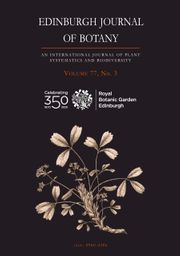Article contents
HIRAEA CUNEATA, H. MACROPHYLLA, ANDFOUR NEW SPECIES CONFUSED WITH THEM: H. HATSCHBACHII,H. OCCHIONII, H. REITZII, AND H.RESTINGAE (MALPIGHIACEAE)
Published online by Cambridge University Press: 07 November 2014
Abstract
Specimens of Hiraea (Malpighiaceae) from the Brazilian states ofeastern Minas Gerais, Rio de Janeiro, Paraná, and Santa Catarina thathad been determined as H. cuneata Griseb. and H.wiedeana A.Juss. were found to include four undescribed species.The assemblage traditionally named Hiraea cuneata includes, inaddition to H. cuneata (Minas Gerais, Rio de Janeiro), twonovelties: H. hatschbachii C.E.Anderson (Paraná) andH. occhionii C.E.Anderson (Rio de Janeiro). The gatheringslabelled Hiraea wiedeana comprise specimens of H.reitzii C.E.Anderson (Paraná, Santa Catarina) andH. restingae C.E.Anderson (Rio de Janeiro), here newlydescribed, and of H. macrophylla (Colla) P.L.R.Moraes& Guglielmone (Rio de Janeiro), the earlier and correct name for thespecies also known as H. wiedeana. In all, the flowers areborne in a single 4-flowered umbel instead of a compound arrangement, as isoften characteristic of other species of Hiraea. Specimensassigned to Hiraea cuneata have the laminas abaxially sericeousinitially but glabrous at maturity. In those assigned to Hiraeawiedeana the laminas are abaxially velutinous (eventually glabrescentin H. restingae). Full descriptions and synonymies aresupplied, and all species are illustrated.
Keywords
Information
- Type
- Articles
- Information
- Copyright
- Copyright © Trustees of the Royal Botanic Garden Edinburgh 2014
References
- 6
- Cited by

